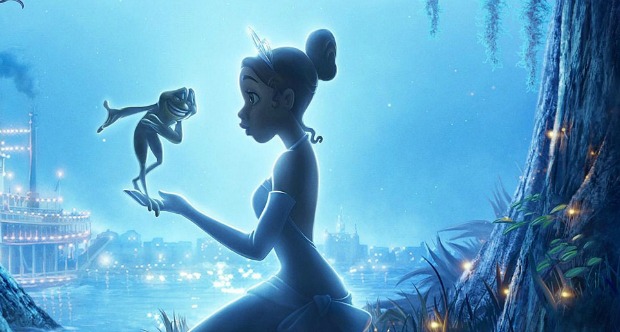The Princess and the Frog
The first Disney 2D animated release since Home on the Range in 2004, and the lead character is African-American, the first black Disney Princess.
Plot summary
A fairy tale set in Jazz Age-era New Orleans and centred on a young woman named Tiana and her fateful kiss with a frog prince who desperately wants to be human again.

The Princess and the Frog, the latest offering from the Disney studios, is set in the French Quarter of New Orleans during the ‘Jazz Age’ and don’t you know it from the opening sequence to the closing credits, with bustling Mardi Gras scenery and new, but somewhat familiar, sounding show tunes as the film is scored by Disney stalwart Randy Newman.
Tiana is a waitress with big dreams of opening her own restaurant, a vision she shared with her late father. Her mother works as a seamstress for local business magnate “Big Daddy” La Bouff, and Tiana has grown up with his daughter and childhood friend, the spoiled but well-meaning Charlotte (imagine a slightly horrifying cross between Scarlett O’Hara and Paris Hilton). When Prince Naveen, a royal playboy from faraway Maldonia, arrives in town, La Bouff throws a ball in his honour. Charlotte thinks she has found her knight in shining armor, although she seems more concerned with marrying a prince than the prince himself, and Naveen sees an answer to his financial problems after being cut off by his parents. Just to throw a spanner in the works, an unfortunate situation involving evil voodoo magician Dr Facilier and a jealous valet sees Prince Naveen becoming prince green – he gets turned into a frog.
As in the Grimm brothers’ fairytale “A Frog Prince”, a princess kissing a frog is central to the film, but with a twist. Frog Naveen convinces Tiana, who he mistakes for a princess as she is dressed up in one of Charlotte’s dresses, to kiss him. Instead she is also turned into a frog, and the two of them must find a way to return to their former selves, aided by a trumpet-playing alligator and a buck-toothed Cajun firefly as they travel the length of the Bayou River.
The Princess and the Frog has drawn media attention for two reasons – it is the first Disney 2D animated release since Home on the Range in 2004, and the lead character is African-American, the first black Disney Princess. Certainly it is a charming return to form – for those who grew up loving Disney from classics like The Jungle Book and Cinderella to the more recent Aladdin – and the film really cuts the mustard when it comes to the Disney formula.
There seems to be a trend for making children’s films packed with nudging jokes for adults that started off rather well with Toy Story but has become a tired device that has started to grate on many audiences. Luckily, The Princess and the Frog largely avoids this, focusing on gentle wit rather than self-referential gags that feel shoehorned in.
It would be impossible to review the film without mentioning the topic of race. The narrative often skirts around the issue, and sure enough it is not the focus of the story. A few references are made to Tiana’s “background” and the opening sequence nods to the situation in the transition between the row of grand colonial mansions in the area where La Bouff lives, and the modest wooden homes in Tiana’s neighbourhood, where she witnesses food bringing her local community closer, and hopes her restaurant will be a place where people “from all walks of life” can come together. It is not surprising that Oprah Winfrey, who provides the voice of Tiana’s mother Eudora, has backed the film so passionately – but it is a credit to the filmmakers that race politics does not dominate the film but exists as just one thread of a larger picture.
The Princess and the Frog is sentimental, overwhelmingly vibrant, silly, and formulaic – all in all a brilliant Disney film. Well worth a watch for big kids, who remember the good old days before CGI animation dominated children’s films, as well as the real ones.











COMMENTS